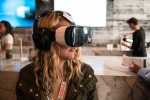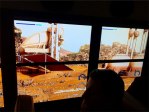
2016 saw an explosion in virtual experiences created by brands for their customers. And by virtual experiences I don’t just mean VR. If you look closely there has been an expansion in all kinds of virtual experiences from chatbots, to drawing applications to AR games. We’ve arrived at a crossroads in communications technology.
One key driver of this explosion is clearly cost. VR was prohibitively expensive only two years ago, but is gradually coming within reach of even home users. Oculus Rift comes in at under $600 and Google Cardboard works with any smartphone and is just $20. Couple that with ever increasing processing power that is now available on small handsets or headsets and it’s clear that we have reached a tipping point in quality for these kinds of interaction. And quality plus cost is driving uptake from both brands and consumers.
But it’s not just about practical realities. For something to take off in this way there has to be a deeper resonance with a human need or desire. I believe it boils down to three key factors:
- Hyper-real
- Storydoing brains
- Expectations of connection
Hyper-real
Mintel have identified a search for authenticity that has been driving brand interactions for some years now. It can manifest in searching for the an expectation that brands will be more open and more honest in conversation. But it can also manifest in a desire to come closer to ‘the real thing’, particularly when that thing is difficult to show in reality. Take for example Samsung’s gear VR rollercoaster, Yes, they have used it to demonstrate the power of Gear but they are also bringing a familiar moment in which to experience that. It’s relatable and understandable and it’s excitingly realistic. Other great examples of a desire for the hyper-real include Marriott’s The Teleporter, which allows you to travel to a Hawaiian beach and London hotel and Merrell’s virtual hike which combines vision and movement to create a walk in the Dolomites which is actually scary! Land Rover’s recent I-Pace VR at the LA Auto Show is a prime example of this. A futuristic landscape combines with the real features and design of the forthcoming electric vehicle to create a deeply immersive experience about a product you can’t yet buy, but will be purchasable in the near future.
VR offers the chance to bring to life near future scenarios particularly in product development or display that drive uptake and excitement. This isn’t dreaming it’s hyper-reality.
Storydoing brains
 Our brains are hard-wired for stories. Bowker reports that over one million (1,052,803) books were published in the U.S. in 2009, which is more than triple the number of books published four years earlier Even logical problems are more easily solved when they are embedded inside the fictional world of story. We also experience the world through a combination of senses. For this reason a story that goes beyond the telling to the directly experiential, the doing, is a powerful way of communicating. Virtual experiences can take us beyond even what we can imagine to a new way of experiencing messages and moments. Take, for example, the Lockheed Martin VR bus that let children ride to school as if they were living on Mars. or Superman VR Roller Coaster at Six Flags amusement park.
Our brains are hard-wired for stories. Bowker reports that over one million (1,052,803) books were published in the U.S. in 2009, which is more than triple the number of books published four years earlier Even logical problems are more easily solved when they are embedded inside the fictional world of story. We also experience the world through a combination of senses. For this reason a story that goes beyond the telling to the directly experiential, the doing, is a powerful way of communicating. Virtual experiences can take us beyond even what we can imagine to a new way of experiencing messages and moments. Take, for example, the Lockheed Martin VR bus that let children ride to school as if they were living on Mars. or Superman VR Roller Coaster at Six Flags amusement park.
We love stories and virtual experiences can tell us stories in new and immersive ways. Why wouldn’t we gravitate towards them?
Expectations of connection
Service has become a price of entry for any brand in the market but expectations of service are dramatically different even than they were 5 years ago. Social media has brought immediacy and changed expectations of what counts as ‘fast’; a global ‘always on’ culture has driven an expectation of 24/7 interaction, and customers feel more empowered. To provide the kinds of service that people need brands have turned to robots. These range from intelligences like Watson from IBM which can drive extremely human like interactions with physical robots such as Pepper to much simpler chatbots who can answer the most common customer questions completely on brand, and 24/7, like Audi’s chatbot from the Frankfurt auto show.
This ‘Robot Renaissance’ as Rohit Bhargava calls it, focuses as much around striving to be as human as possible as it does around replacing humans, a kind of Virtual Humanity, if you will. And with machine learning these kinds of virtual interactions will only become more lifelike and satisfying.
What is the value to brands?
Clearly for brands who have technology at their heart the move into all things virtual is simply a stop on their journey. But you can only ride that wave for so long before everyone is doing it and you no longer stand out. Where then is the value in this virtual world we are creating?
As products become commoditized so experiences that communicate what a brand stands for become essential. They’re the differentiator, the reason to believe and to buy. The best virtual experiences bring humanity, connection and dreams to life in a way that is expressive of the brand. They generate an emotional moment that allows the consumer to really understand what you are about and to form an affinity with your product, brand or positioning which is rooted in personal experience.
Virtual experiences that create connections, drive emotions, and deliver immersions will make your brand stand out in a sea of gimmicks and lightweight conversations. The virtual world is your oyster.
